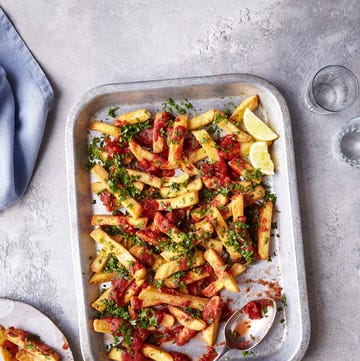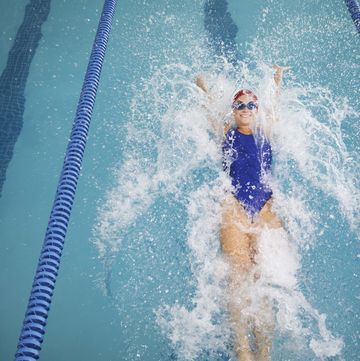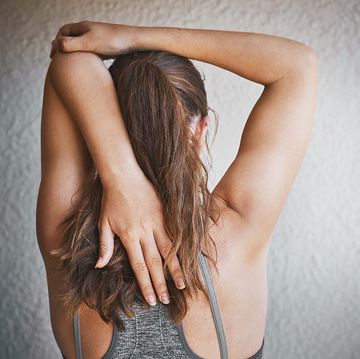Forget the 5:2 or going Paleo because a new lifestyle plan has taken over as the hottest diet: The Pioppi Diet.
It promises not only to help you lose weight, but to live longer, too. The best bit? You don't even have to hit the gym...
The plan was inspired by the residents of Pioppi, a village in Southern Italy that is famously known as the healthiest place in the world, where locals live for 10 years longer than average and don't seem to suffer from chronic diseases, all while enjoying delicious food and a glass of wine every evening.
Created by renowned consultant cardiologist Dr Aseem Malhotra, advisor to the National Obesity Forum, and filmmaker Donal O'Neill, the 21-day lifestyle plan aims to debunk longstanding dietary myths, and help followers slim down, while also reducing their risk of developing type 2 diabetes, cancer, dementia and heart disease.
Sounds pretty good right?
Here, we chat to Dr Malhotra about The Pioppi Diet to discover everything you need to know about this year's hottest diet plan...
Why did you focus on the village of Pioppi?
This is the village where American scientist Ancel Keys spent six months of the year for over 30 years, conducting his research into the cause of heart disease. His research, now found to be flawed in its relation to saturated fat, cholesterol and heart disease was responsible for pushing the low fat food movement in the late 1970s.
In fact, the book explains why this is one root cause behind the explosion in type 2 diabetes and obesity we've seen in the past few decades.
Pioppi itself has some of the healthiest people in the world, with average life expectancy close to 90 for men and women, and many people living healthily to over 100.
We wanted to discover what their secrets were for good health were and marry that up with modern up to data.
What makes The Pioppi Diet different from other plans?
As well as busting many myths prevalent in today's diet and health industries, its focus is on lifestyle as a whole, covering nutrition, exercise (or what we prefer to call 'mindful movement') stress, sleep and the importance of social interaction.
One of the best parts of plan is that you don't have to count calories – you just eat when you're hungry and until full provided you don't snack in between which is easy to do once you break the sugar and refined carb cycle.
Why 21 days? Is the plan sustainable in the longer-term?
We chose 21 days for a number of reasons, which included giving people the time to break their cycle of addiction to sugar and refined carbohydrates – the foods that drive insulin resistance, which is at the root of many chronic diseases – and enough time to see improvements in both their health markers and weight.
Our personal experience, and my own experience with patients so far, reveals that the plan is sustainable long term, mainly because it doesn't involve counting calories, and it's also enjoyable because the food is delicious.
What are the core principles of the plan?
- Going cold turkey on all added sugars for the first two weeks, cutting out all bread, pasta and rice.
- No snacking but eat until you feel full.
- Ensuring you get at least two-to-four tablespoons of extra virgin olive oil per day, and a small handful of nuts.
- As there's no fear of fat, you can eat butter, cheese and full-fat yoghurt.
- Walking at least 30 minutes a day.
- Aiming to get at least 7 hours sleep a night.
- Concentrating on reducing stress through breathing exercises.
Which foods are banned in the plan, and why? Is alcohol allowed?
No bread, pasta, rice, or added sugars, including fruit juice, honey, smoothies and syrups. You also need to cut out industrial seed oils, such as sunflower and soybean oil.
You don't have to drink but alcohol is allowed, as long as you keep within the guideline of 14 units a week . We also advise you to drink like they do in the Mediterranean, meaning a glass of wine with meals, NOT binge drinking!
Which foods are you encouraged to eat more of, and why?
The strongest scientific evidence from many studies on positive biological effects that improve health and reduce the risk of heart attack, stroke, cancer and dementia come from extra virgin olive oil, nuts, whole fruit and vegetables and oily fish, so the plan is based around them.
The alpha linoleic acid, polyphenols and omega 3 fatty acids within these foods rapidly reduce inflammation, and provide great nutrition.
What part does activity play? Is it true we won't need to visit the gym?
Regular movement is crucial to good health. The average villager in Pioppi lives for almost 10 years longer than the average Tour De France cyclist, without doing any 'exercise'. Instead, they just walk everywhere.
In terms of longevity, a large study of ex-Olympians reveals that elite athletes don't live any longer than golfers or cricketers, meaning that a little activity goes a long way.
We advise you not sit for more than 45 minutes at a time, as even getting up for two minutes and having a stretch has significant health benefits.
Why is fasting included in the plan?
It's a very powerful intervention to reduce insulin resistance. We advise fasting for one 24-hour period each week, without ever going to bed hungry, meaning you fast from dinner to dinner the next day.
Through this, you extend the natural overnight fast by not eating breakfast or lunch, but consume fluids, including tea, coffee and water during that time.
You advocate sleeping for 7 hours – why is this such a crucial part of the plan?
Studies have shown that getting an average of less than seven hours' sleep a night is associated with type 2 diabetes, heart disease, obesity and depression. It's also closely tied into stress.
You recommend spending more time socialising – why is this?
Social isolation is a big risk factor for depression and premature death, especially in the elderly. Positive social interactions and good relationships help mitigate the impact of external stress, which is also linked to inflammation.
Why did you choose to incorporate breathing exercises in the plan?
It all comes back to being mindful. With our fast-paced lives, we often forget to take deep breathes and properly relax. Only when you do this properly and regularly will you start to notice the difference.
What are the main health benefits of the plan? And how much weight can we expect to lose?
The weight loss will vary from person to person. But, to be honest, that's the wrong question. This plan is designed to make every size and shape healthier with weight loss as a side effect.
What's different about this plan is that it concentrates first and foremost on good health. If you follow it and are overweight or have weight in the wrong place, such as the around your belly then you'll lose it.
Meanwhile, if you have a normal body mass index (BMI), it will also put you in better short-term and-long term health.
It's important to note that up to 40% of individuals with a normal BMI will suffer many of the same lifestyle-related diseases as those with obesity, and up to a third of people with type 2 diabetes are normal weight. There is therefore no such thing as a 'healthy' weight, only a healthy person.
Finally, can the plan really reduce our risk of disease, and ultimately help us live longer?
We've brought together all of the up-to-date, commercial-interest-free science to produce a plan that will most definitely have a significant impact to reduce the risk of disease and help us age well.
If the whole of the UK adult population followed this plan, we'd quite easily start to see a reversal in the twin epidemics of type 2 and obesity within a year.
BUY NOW The Pioppi Diet by Dr Aseem Malhotra and Donal O'Neill (Michael Joseph) – £6.47, Amazon

Francesca is the Digital Editor of Red, overseeing all sections of the site. She loves travel, books and pizza, so a beach holiday in Italy is pretty much her dream scenario.















